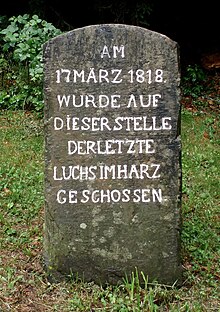Lynx stone (West Harz)
The lynx stone in the Harz is a historical memorial stone near Lautenthal in the Lower Saxony district of Goslar . It commemorates the last lynx hunted in this low mountain range (1818).
Geographical location
The Luchsstein stands between the nearby Lautenthal in the east-southeast and the somewhat distant Seesen in the west-northwest on the southern slope of the Großer Trogtaler Berg ( 608.6 m above sea level ). It is located next to a forest road at an altitude of about 530 m .
history
The memorial stone was erected not far from the place where the royal Hanoverian riding forester Spellerberg from Lautenthal hunted the last lynx of the Harz Mountains on March 17, 1818 in the Kaltenbirk hunting district on the Teufelsberg during an eleven or 17-day hunt. Around 200 hunters and drivers were then on duty to track down the lynx as - according to the opinion of the time - a wild predator and bring it down.
At that time there was no protest against the extermination of this animal, on the contrary, the said memorial stone was even erected. This last lynx was stuffed and exhibited in the museum in Braunschweig , today in the Natural History Museum . In addition, G. Schröder made an engraving in memory of the killing of this lynx.
In the eastern Harz, the last lynx was hunted a year earlier on March 24, 1817 in the county of Wernigerode . The lynx stone there reminds of this . For a long time this lynx was considered to be the last of its kind in the Harz Mountains. The animal was professionally prepared by A. Berger in Braunschweig on behalf of Count Henrich zu Stolberg-Wernigerode and exhibited in the Count's-Stolberg natural history cabinet in the orangery in Wernigerode . This groomed lynx is still preserved today as a museum exhibit. The lynx was last in the Harz Museum Wernigerode.
The last wild brown bear was shot in the Lower Harz a century earlier . The bear monument near Bremer Teich in the Anhalt Harz region is a reminder of this .
On the other hand, the Ferdinand's stone near the Plessenburg near Ilsenburg reminds of the last free-living wolf, which was shot by Count Ferdinand zu Stolberg-Wernigerode .
It was not until 1999 that the Harz National Park released lynxes back into the western Harz. Since then, these lynxes have reproduced well and are spreading in northern Germany, central Germany and northern Hesse. The lynx monument east of Torfhaus reminds of the resettlement .
hike
The forest road that leads past the Luchsstein is also used as a hiking and cycling path. In particular, the Harzer Försterstieg runs there . The lynx stone on the side of the path is included as No. 103 in the system of stamping points of the Harz hiking pin.
Individual evidence
- ↑ Map services of the Federal Agency for Nature Conservation ( information )
- ↑ Harzer Wanderadel: stamp point 103 / Luchsstein , on harzer-wandernadel.de
Web links
- The lynx stone (description with photo), on harzlife.de
- The lynx project Harz (lynx reintegration), on luchsprojekt-harz.de
- Information from the Natural History Museum in Braunschweig: The mammal collection. Retrieved April 19, 2016 . , on natural-history-museum
- Picture of the stuffed lynx in the Natural History Museum in Braunschweig , on falk-media.de
Coordinates: 51 ° 52 ′ 49.2 " N , 10 ° 15 ′ 20.4" E

